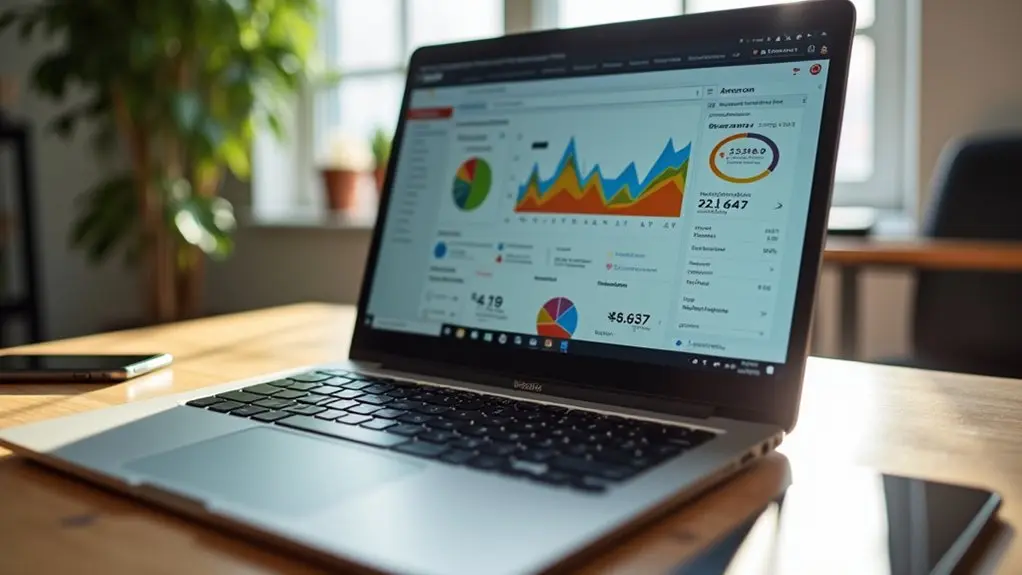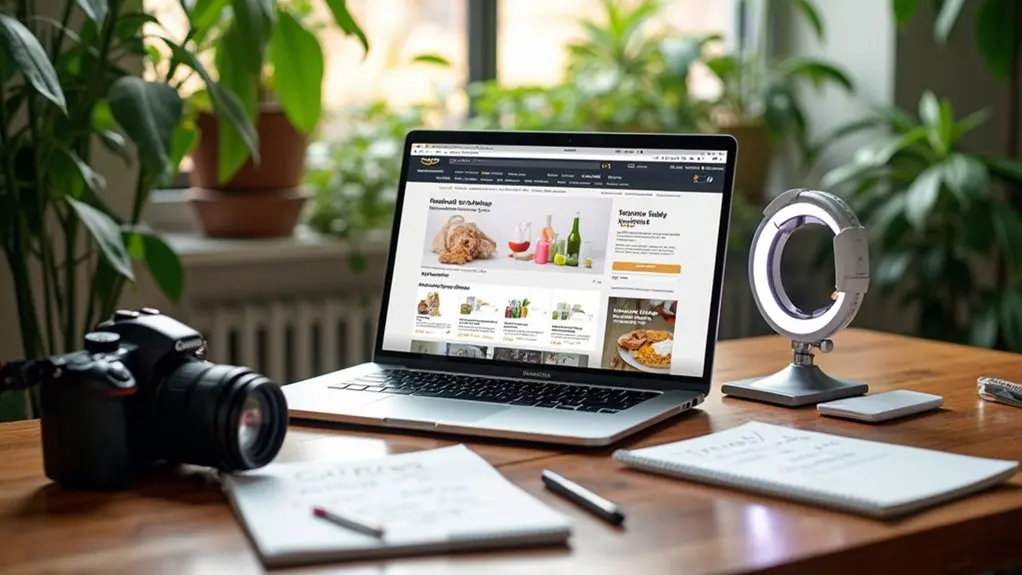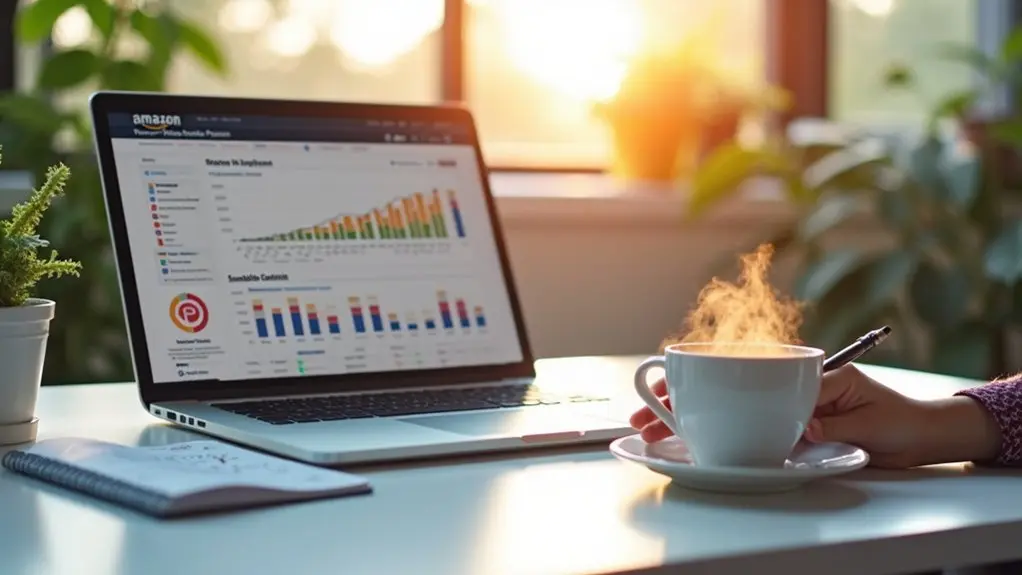Amazon charges your card when the shipping process for your order begins. If you're buying from third-party sellers, they might charge you right away or once shipping is confirmed. For pre-orders, charges occur a few days before release. Backordered items are charged only when ready to ship, preventing unexpected costs. Your card may experience authorization holds when you place orders, but these are canceled if items are out of stock. Immediate charges apply to gift cards, whereas membership fees are deducted upfront upon joining. Understanding these protocols can optimize your purchasing strategy and keep your finances in check.
Key Takeaways
- Amazon charges cards when the shipping process begins for direct orders.
- Third-party sellers may charge immediately or upon shipping.
- Pre-orders are charged a few days before release or when ready to ship.
- Authorization holds are placed when orders are made, canceling if out of stock.
- Debit card transactions follow the same timing as credit card charges.
Payment Timing for Orders
When you're shopping on Amazon, understanding when your card will be charged is essential for managing your finances. Knowing how the charging process works can help you anticipate expenses.
Typically, Amazon will charge your card when the shipping process begins for items ordered directly from them. This guarantees that you're only billed once the product is on its way. For third-party sellers, the charging process can vary; they may charge your card immediately upon purchase or wait until the item ships.
For pre-orders, Amazon will charge your card a few days before the release date or when the item is ready to ship. This strategy guarantees that your order is fulfilled promptly upon availability.
In the case of backordered items, your card is only charged once the product is available and ready for shipping.
If you decide to cancel an order before it ships, Amazon won't charge your card. However, once an item is marked as shipped, it can't be cancelled, though you may be eligible for a refund if the item is unsatisfactory.
Amazon adheres to FTC regulations, prohibiting any charges before shipment, guaranteeing transparency and customer satisfaction.
Amazon Payment Methods
When using a credit card for Amazon purchases, expect charges to align with shipping processes, typically occurring as your item is prepared for dispatch.
However, if you're using a gift card, Amazon secures funds immediately, ensuring payment is confirmed at the point of transaction.
Analyzing these methods reveals Amazon's strategy to balance customer convenience with payment security across different purchasing scenarios.
Credit Card Billing Timing
In understanding how Amazon manages credit card billing timing, it's essential to recognize the precise moments when charges occur. When you purchase items sold directly by Amazon, the Amazon Charge typically appears on your credit card when the shipping process begins. This guarantees that payments are only taken for orders that Amazon fulfills, aligning charges closely with product delivery.
For third-party Marketplace sellers, the timing of charges can be less predictable. Some retailers might bill your credit card immediately after you place an order, while others wait until shipping confirmation. This variability highlights the importance of checking individual seller policies to manage your expectations effectively.
Additionally, the timing of Amazon debit card transactions mirrors that of credit cards, as deductions occur when shipping starts. This consistency across payment methods helps you anticipate when funds will leave your account.
Gift Card Immediate Charges
Understanding the timing of charges is just as important when using gift cards as it's with credit or debit cards. On Amazon, gift card immediate charges occur when you purchase the gift card itself. Unlike credit or debit card transactions, where charges might align with delivery schedules, the full amount for a gift card is deducted from your account upfront. This means you're charged immediately, regardless of when or if the gift card is eventually redeemed.
When you're buying a gift card, Amazon guarantees the transaction is processed without delay, providing certainty in your account management. This immediate charge contrasts with the variability seen in credit or debit card purchases, where the billing might depend on shipping or item availability. It's essential to recognize that while gift cards can be used for buying items in your cart, the initial charge has already been settled at purchase time.
However, note that Amazon gift cards can't be used for recurring subscription payments, which rely on separate payments through your selected credit or debit card.
Understanding these nuances helps optimize your payment strategy on Amazon and prevents unexpected charges.
Prime Membership Charges
Steering through the intricacies of Prime membership charges reveals that Amazon offers flexibility through either monthly or annual billing plans.
When you sign up, the payment is processed immediately, confirming your membership and ensuring timely billing from the release date of your subscription. If you're not ready to commit long-term, the monthly plan might be ideal, while an annual plan could save you money if you're ready to ship into a year-long commitment.
Here's what you need to know about managing Prime charges:
- Cancellation Timing: To avoid being charged for the next billing cycle, cancel your subscription before the next payment date.
- Pause Option: You have the option to pause your membership. This allows retention of benefits like photo storage without incurring charges during the pause.
- Refund Eligibility: If you cancel an annual membership, you might get a refund for the unused portion, provided you act before the next charge.
- Billing Confirmation: Payments confirm your membership, ensuring access to benefits and preventing service interruptions.
Analyzing these aspects helps you manage your Prime membership seamlessly, aligning your preferences with Amazon's billing structure.
Order Cancellation Policies
While managing your Prime membership charges is important, it's equally critical to understand Amazon's order cancellation policies to avoid unnecessary costs. You can cancel orders without incurring charges as long as the shipment isn't confirmed. This means the cancellation must occur before the order is marked as shipped.
Once the shipment is confirmed, canceling is no longer an option, though you might still qualify for a refund if the product received doesn't meet your expectations.
Amazon's process guarantees that merchants fulfill orders by either providing more stock or issuing refunds for unfulfilled orders. The key detail here is that charges typically don't occur until the shipping process begins. This means you're not billed prematurely, providing a buffer to manage your orders effectively.
To stay on top of your orders, Amazon sends email notifications regarding your order status. Checking these regularly lets you verify stock availability and act quickly to cancel if needed.
Additionally, if an item is out of stock, any authorization hold on your card is automatically canceled, assuring you're not charged for undeliverable products. Understanding these policies helps you manage your purchases efficiently.
Additional Fees and Charges
When selling on Amazon, you need to contemplate additional fees like per-unit charges for oversized products, which can greatly impact your overall expenses.
If you use the FBA Inventory Placement Service, sending all inventory to one fulfillment center might reduce shipping costs for smaller items, but it could also incur extra fees.
Analyzing these costs helps you optimize pricing strategies and maintain profitability.
Oversized Product Fees
Maneuvering the landscape of Amazon's oversized product fees can be crucial for both sellers and buyers aiming to optimize costs.
As a seller, understanding these fees is critical. Amazon imposes additional per-unit fees for oversized products, which are higher than those for standard-sized items. These fees are determined by the product's dimensions and weight, directly impacting the total shipping costs.
This makes it essential for third-party sellers to incorporate oversized product fees into their pricing strategies to remain competitive.
For buyers, the impact of oversized product fees is noticeable at checkout. These fees can increase the overall cost of your order, so it's important to be aware of how they might affect your final bill.
Here's how they work:
- Fee Calculation: Fees are based on size and weight, which could lead to significant cost differences.
- FBA Advantage: Sellers using Fulfillment by Amazon may lower costs by sending inventory to a single center.
- Pricing Strategy: Third-party sellers need to adjust prices to account for these additional fees.
- Awareness for Buyers: Knowing these fees helps you understand why costs might spike unexpectedly during checkout.
Inventory Placement Costs
Maneuvering Amazon's Inventory Placement Costs requires a clear understanding of the associated fees and their impact on your bottom line. Amazon imposes per-unit fees for its Inventory Placement Service, which simplifies logistics by allowing you to send all inventory to a single fulfillment center.
However, these fees can vary greatly, particularly increasing for oversized or large products due to the additional handling and storage requirements. This service can be advantageous for streamlining the shipping process, especially for smaller, less profitable items, as it reduces the necessity of dispatching multiple shipments to different centers.
To effectively manage your logistics and pricing strategies on Amazon, it's essential to understand the cost structure of the Inventory Placement Service. While it offers the convenience of centralized shipping, these additional fees may impact your overall profit margins.
When dealing with Amazon Basics or any other product line, factoring in these costs is vital for maintaining profitability. Evaluating whether the Inventory Placement Service aligns with your business model and product offerings can lead to considerable savings in shipping and handling, ultimately affecting your pricing strategies and bottom line positively or negatively.
Managing Out of Stock Products
Managing out-of-stock products on Amazon involves a strategic approach to confirm customer satisfaction and financial accuracy. When an item you want is out of stock, Amazon guarantees you aren't charged immediately. This is vital to maintain trust and transparency in transactions.
Here's how Amazon manages this process effectively:
- Authorization Holds: When you place an order, Amazon might place an authorization hold on your card. If the item is out of stock, this hold is canceled, so you're not prematurely charged.
- Back in Stock Notifications: To make certain you don't miss out, Amazon offers notifications for when products are back in stock. This way, you can promptly act and order the item once it's available again.
- 1-Click Ordering: While this feature might authorize charges immediately, it doesn't guarantee stock availability. If the product is unavailable, any charges are reversed, aligning with Amazon's policy of charging only when shipping is imminent.
- Charge Timing: You're only billed when items are ready to ship, protecting you from being charged for products that can't be delivered. This strategic approach allows you to plan your finances effectively, knowing you won't incur unexpected costs.
Frequently Asked Questions
Does Amazon Charge Your Debit Card Right Away?
Amazon doesn't always charge your debit card immediately. Debit card processing depends on payment authorization policies. Charge timing varies by seller and product type, like pre-orders or third-party purchases, affecting when funds are deducted from your account.
How Does Amazon Charge Your Credit Card?
Amazon's payment process for credit cards is systematic. They charge during the shipping phase, aligning with your billing cycle. For pre-orders, charges occur near release, ensuring precise inventory management and seamless transaction accuracy.
Does Amazon Take Payment Straight Away?
Amazon's payment processing doesn't typically occur straight away. They charge during specific billing cycles, like when your order ships. Exceptions include immediate charges on gift cards or third-party sellers, depending on their individual billing policies.
Why Does Amazon Not Charge You Right Away?
Amazon doesn't charge you right away because they prioritize payment authorization and efficient order processing. By delaying charges until shipping, they guarantee compliance with regulations and optimize transaction accuracy, enhancing customer satisfaction and financial transparency.
Conclusion
You've navigated Amazon's payment processes, understanding when and how your card is charged. By analyzing payment timing and accepted methods, you've guaranteed smooth transactions. You've also grasped Prime membership billing and cancellation policies. Awareness of potential additional fees helps avoid surprises. Proactively managing out-of-stock products can prevent delays. By leveraging this detailed, data-driven understanding, you can efficiently handle your Amazon purchases, minimizing disruptions and maximizing benefits. Your informed approach puts you in control.




